Strategic Alliances and International Business Expansion Report
VerifiedAdded on 2022/11/28
|11
|3719
|164
Report
AI Summary
This report examines the strategic alliances formed by businesses to facilitate international expansion and gain a competitive advantage in the global market. It begins with an introduction to strategic alliances, defining them as partnerships between companies based in different countries, and reviews relevant literature on the topic. The main body of the report delves into different types of alliances, including international joint ventures, and discusses the advantages and disadvantages of each. The analysis and discussion section provides case studies of Air France-KLM and Lufthansa Group, highlighting their strategic alliances and the benefits they have realized. The report concludes by summarizing the key findings and emphasizing the importance of strategic alliances in today's globalized business environment.

Report
Paraphrase This Document
Need a fresh take? Get an instant paraphrase of this document with our AI Paraphraser
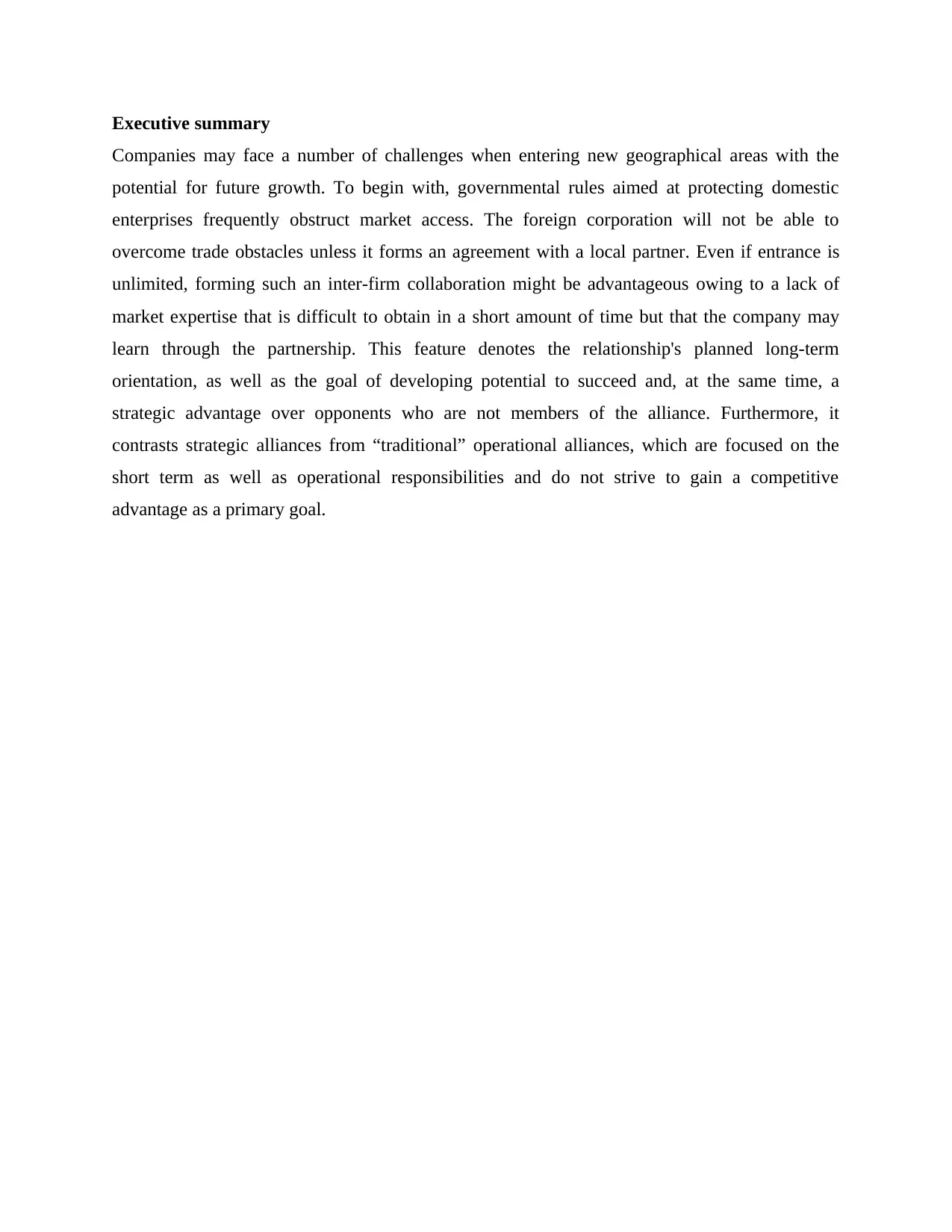
Executive summary
Companies may face a number of challenges when entering new geographical areas with the
potential for future growth. To begin with, governmental rules aimed at protecting domestic
enterprises frequently obstruct market access. The foreign corporation will not be able to
overcome trade obstacles unless it forms an agreement with a local partner. Even if entrance is
unlimited, forming such an inter-firm collaboration might be advantageous owing to a lack of
market expertise that is difficult to obtain in a short amount of time but that the company may
learn through the partnership. This feature denotes the relationship's planned long-term
orientation, as well as the goal of developing potential to succeed and, at the same time, a
strategic advantage over opponents who are not members of the alliance. Furthermore, it
contrasts strategic alliances from “traditional” operational alliances, which are focused on the
short term as well as operational responsibilities and do not strive to gain a competitive
advantage as a primary goal.
Companies may face a number of challenges when entering new geographical areas with the
potential for future growth. To begin with, governmental rules aimed at protecting domestic
enterprises frequently obstruct market access. The foreign corporation will not be able to
overcome trade obstacles unless it forms an agreement with a local partner. Even if entrance is
unlimited, forming such an inter-firm collaboration might be advantageous owing to a lack of
market expertise that is difficult to obtain in a short amount of time but that the company may
learn through the partnership. This feature denotes the relationship's planned long-term
orientation, as well as the goal of developing potential to succeed and, at the same time, a
strategic advantage over opponents who are not members of the alliance. Furthermore, it
contrasts strategic alliances from “traditional” operational alliances, which are focused on the
short term as well as operational responsibilities and do not strive to gain a competitive
advantage as a primary goal.
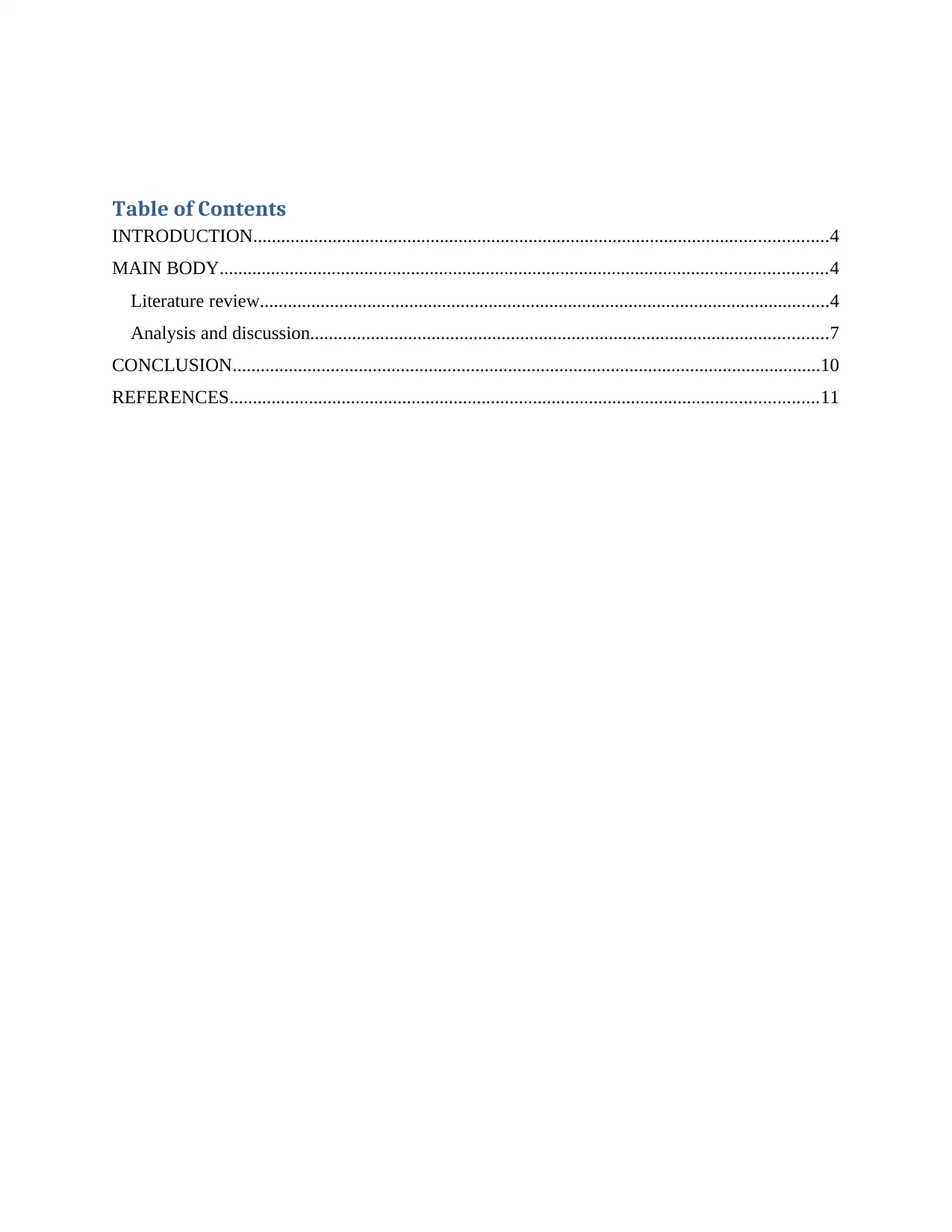
Table of Contents
INTRODUCTION...........................................................................................................................4
MAIN BODY..................................................................................................................................4
Literature review..........................................................................................................................4
Analysis and discussion...............................................................................................................7
CONCLUSION..............................................................................................................................10
REFERENCES..............................................................................................................................11
INTRODUCTION...........................................................................................................................4
MAIN BODY..................................................................................................................................4
Literature review..........................................................................................................................4
Analysis and discussion...............................................................................................................7
CONCLUSION..............................................................................................................................10
REFERENCES..............................................................................................................................11
⊘ This is a preview!⊘
Do you want full access?
Subscribe today to unlock all pages.

Trusted by 1+ million students worldwide
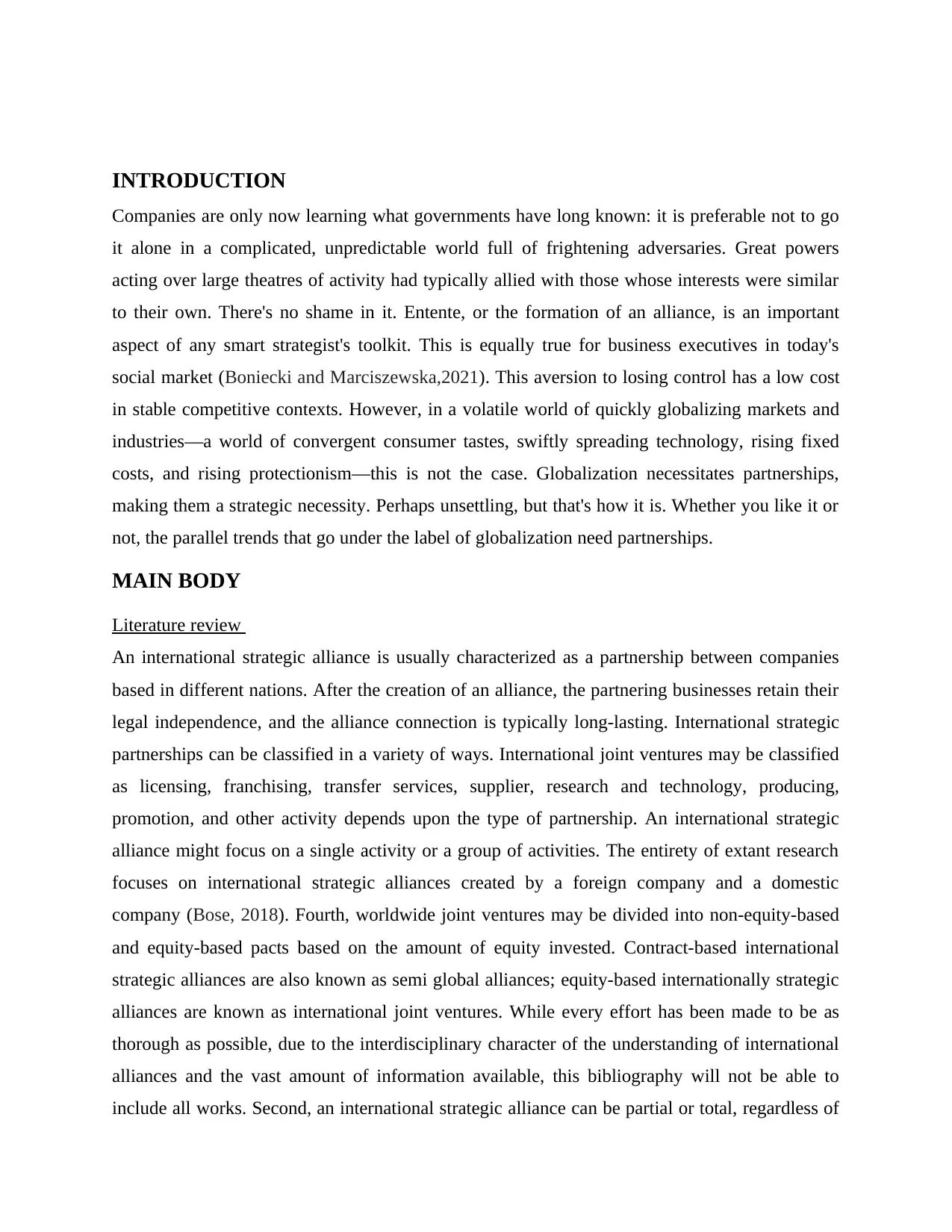
INTRODUCTION
Companies are only now learning what governments have long known: it is preferable not to go
it alone in a complicated, unpredictable world full of frightening adversaries. Great powers
acting over large theatres of activity had typically allied with those whose interests were similar
to their own. There's no shame in it. Entente, or the formation of an alliance, is an important
aspect of any smart strategist's toolkit. This is equally true for business executives in today's
social market (Boniecki and Marciszewska,2021). This aversion to losing control has a low cost
in stable competitive contexts. However, in a volatile world of quickly globalizing markets and
industries—a world of convergent consumer tastes, swiftly spreading technology, rising fixed
costs, and rising protectionism—this is not the case. Globalization necessitates partnerships,
making them a strategic necessity. Perhaps unsettling, but that's how it is. Whether you like it or
not, the parallel trends that go under the label of globalization need partnerships.
MAIN BODY
Literature review
An international strategic alliance is usually characterized as a partnership between companies
based in different nations. After the creation of an alliance, the partnering businesses retain their
legal independence, and the alliance connection is typically long-lasting. International strategic
partnerships can be classified in a variety of ways. International joint ventures may be classified
as licensing, franchising, transfer services, supplier, research and technology, producing,
promotion, and other activity depends upon the type of partnership. An international strategic
alliance might focus on a single activity or a group of activities. The entirety of extant research
focuses on international strategic alliances created by a foreign company and a domestic
company (Bose, 2018). Fourth, worldwide joint ventures may be divided into non-equity-based
and equity-based pacts based on the amount of equity invested. Contract-based international
strategic alliances are also known as semi global alliances; equity-based internationally strategic
alliances are known as international joint ventures. While every effort has been made to be as
thorough as possible, due to the interdisciplinary character of the understanding of international
alliances and the vast amount of information available, this bibliography will not be able to
include all works. Second, an international strategic alliance can be partial or total, regardless of
Companies are only now learning what governments have long known: it is preferable not to go
it alone in a complicated, unpredictable world full of frightening adversaries. Great powers
acting over large theatres of activity had typically allied with those whose interests were similar
to their own. There's no shame in it. Entente, or the formation of an alliance, is an important
aspect of any smart strategist's toolkit. This is equally true for business executives in today's
social market (Boniecki and Marciszewska,2021). This aversion to losing control has a low cost
in stable competitive contexts. However, in a volatile world of quickly globalizing markets and
industries—a world of convergent consumer tastes, swiftly spreading technology, rising fixed
costs, and rising protectionism—this is not the case. Globalization necessitates partnerships,
making them a strategic necessity. Perhaps unsettling, but that's how it is. Whether you like it or
not, the parallel trends that go under the label of globalization need partnerships.
MAIN BODY
Literature review
An international strategic alliance is usually characterized as a partnership between companies
based in different nations. After the creation of an alliance, the partnering businesses retain their
legal independence, and the alliance connection is typically long-lasting. International strategic
partnerships can be classified in a variety of ways. International joint ventures may be classified
as licensing, franchising, transfer services, supplier, research and technology, producing,
promotion, and other activity depends upon the type of partnership. An international strategic
alliance might focus on a single activity or a group of activities. The entirety of extant research
focuses on international strategic alliances created by a foreign company and a domestic
company (Bose, 2018). Fourth, worldwide joint ventures may be divided into non-equity-based
and equity-based pacts based on the amount of equity invested. Contract-based international
strategic alliances are also known as semi global alliances; equity-based internationally strategic
alliances are known as international joint ventures. While every effort has been made to be as
thorough as possible, due to the interdisciplinary character of the understanding of international
alliances and the vast amount of information available, this bibliography will not be able to
include all works. Second, an international strategic alliance can be partial or total, regardless of
Paraphrase This Document
Need a fresh take? Get an instant paraphrase of this document with our AI Paraphraser
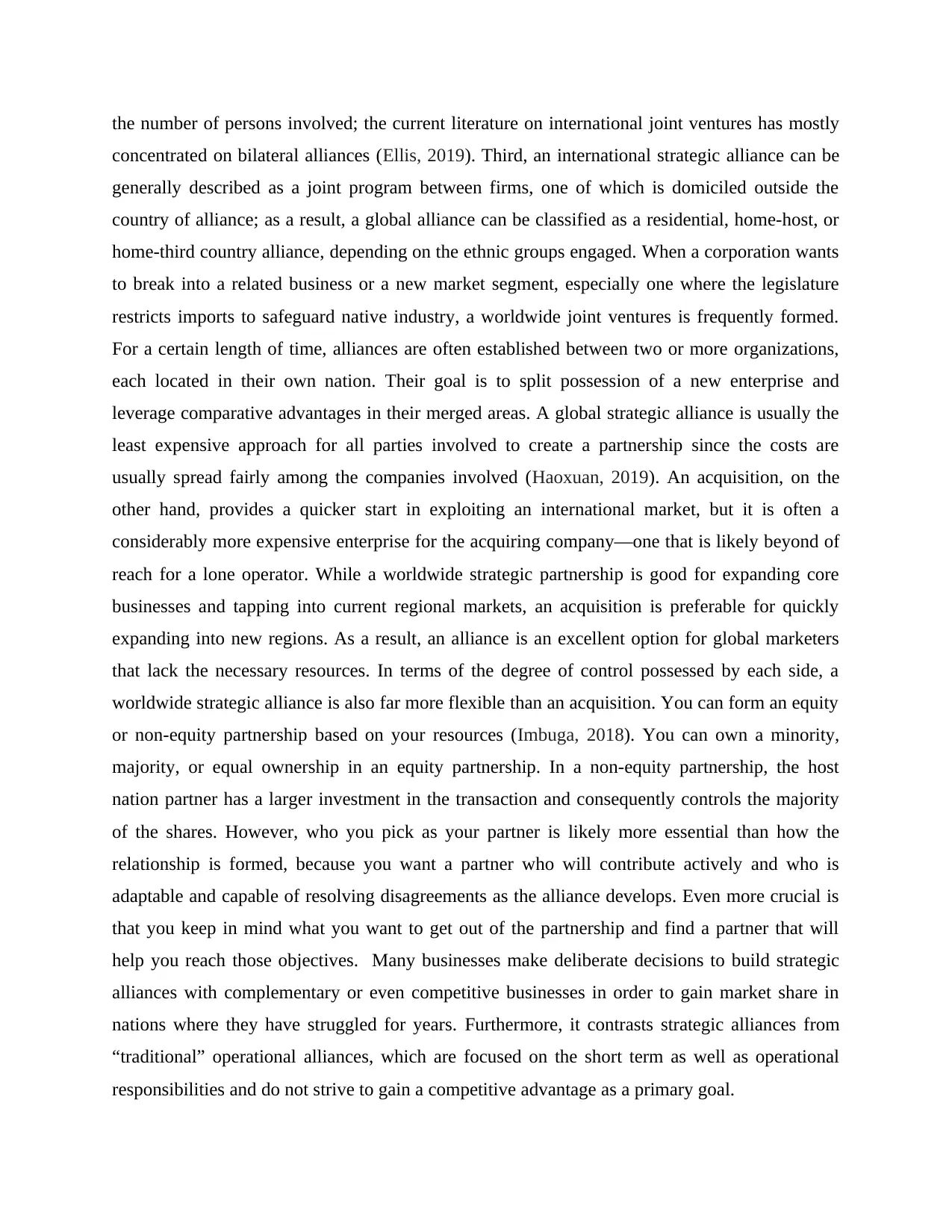
the number of persons involved; the current literature on international joint ventures has mostly
concentrated on bilateral alliances (Ellis, 2019). Third, an international strategic alliance can be
generally described as a joint program between firms, one of which is domiciled outside the
country of alliance; as a result, a global alliance can be classified as a residential, home-host, or
home-third country alliance, depending on the ethnic groups engaged. When a corporation wants
to break into a related business or a new market segment, especially one where the legislature
restricts imports to safeguard native industry, a worldwide joint ventures is frequently formed.
For a certain length of time, alliances are often established between two or more organizations,
each located in their own nation. Their goal is to split possession of a new enterprise and
leverage comparative advantages in their merged areas. A global strategic alliance is usually the
least expensive approach for all parties involved to create a partnership since the costs are
usually spread fairly among the companies involved (Haoxuan, 2019). An acquisition, on the
other hand, provides a quicker start in exploiting an international market, but it is often a
considerably more expensive enterprise for the acquiring company—one that is likely beyond of
reach for a lone operator. While a worldwide strategic partnership is good for expanding core
businesses and tapping into current regional markets, an acquisition is preferable for quickly
expanding into new regions. As a result, an alliance is an excellent option for global marketers
that lack the necessary resources. In terms of the degree of control possessed by each side, a
worldwide strategic alliance is also far more flexible than an acquisition. You can form an equity
or non-equity partnership based on your resources (Imbuga, 2018). You can own a minority,
majority, or equal ownership in an equity partnership. In a non-equity partnership, the host
nation partner has a larger investment in the transaction and consequently controls the majority
of the shares. However, who you pick as your partner is likely more essential than how the
relationship is formed, because you want a partner who will contribute actively and who is
adaptable and capable of resolving disagreements as the alliance develops. Even more crucial is
that you keep in mind what you want to get out of the partnership and find a partner that will
help you reach those objectives. Many businesses make deliberate decisions to build strategic
alliances with complementary or even competitive businesses in order to gain market share in
nations where they have struggled for years. Furthermore, it contrasts strategic alliances from
“traditional” operational alliances, which are focused on the short term as well as operational
responsibilities and do not strive to gain a competitive advantage as a primary goal.
concentrated on bilateral alliances (Ellis, 2019). Third, an international strategic alliance can be
generally described as a joint program between firms, one of which is domiciled outside the
country of alliance; as a result, a global alliance can be classified as a residential, home-host, or
home-third country alliance, depending on the ethnic groups engaged. When a corporation wants
to break into a related business or a new market segment, especially one where the legislature
restricts imports to safeguard native industry, a worldwide joint ventures is frequently formed.
For a certain length of time, alliances are often established between two or more organizations,
each located in their own nation. Their goal is to split possession of a new enterprise and
leverage comparative advantages in their merged areas. A global strategic alliance is usually the
least expensive approach for all parties involved to create a partnership since the costs are
usually spread fairly among the companies involved (Haoxuan, 2019). An acquisition, on the
other hand, provides a quicker start in exploiting an international market, but it is often a
considerably more expensive enterprise for the acquiring company—one that is likely beyond of
reach for a lone operator. While a worldwide strategic partnership is good for expanding core
businesses and tapping into current regional markets, an acquisition is preferable for quickly
expanding into new regions. As a result, an alliance is an excellent option for global marketers
that lack the necessary resources. In terms of the degree of control possessed by each side, a
worldwide strategic alliance is also far more flexible than an acquisition. You can form an equity
or non-equity partnership based on your resources (Imbuga, 2018). You can own a minority,
majority, or equal ownership in an equity partnership. In a non-equity partnership, the host
nation partner has a larger investment in the transaction and consequently controls the majority
of the shares. However, who you pick as your partner is likely more essential than how the
relationship is formed, because you want a partner who will contribute actively and who is
adaptable and capable of resolving disagreements as the alliance develops. Even more crucial is
that you keep in mind what you want to get out of the partnership and find a partner that will
help you reach those objectives. Many businesses make deliberate decisions to build strategic
alliances with complementary or even competitive businesses in order to gain market share in
nations where they have struggled for years. Furthermore, it contrasts strategic alliances from
“traditional” operational alliances, which are focused on the short term as well as operational
responsibilities and do not strive to gain a competitive advantage as a primary goal.
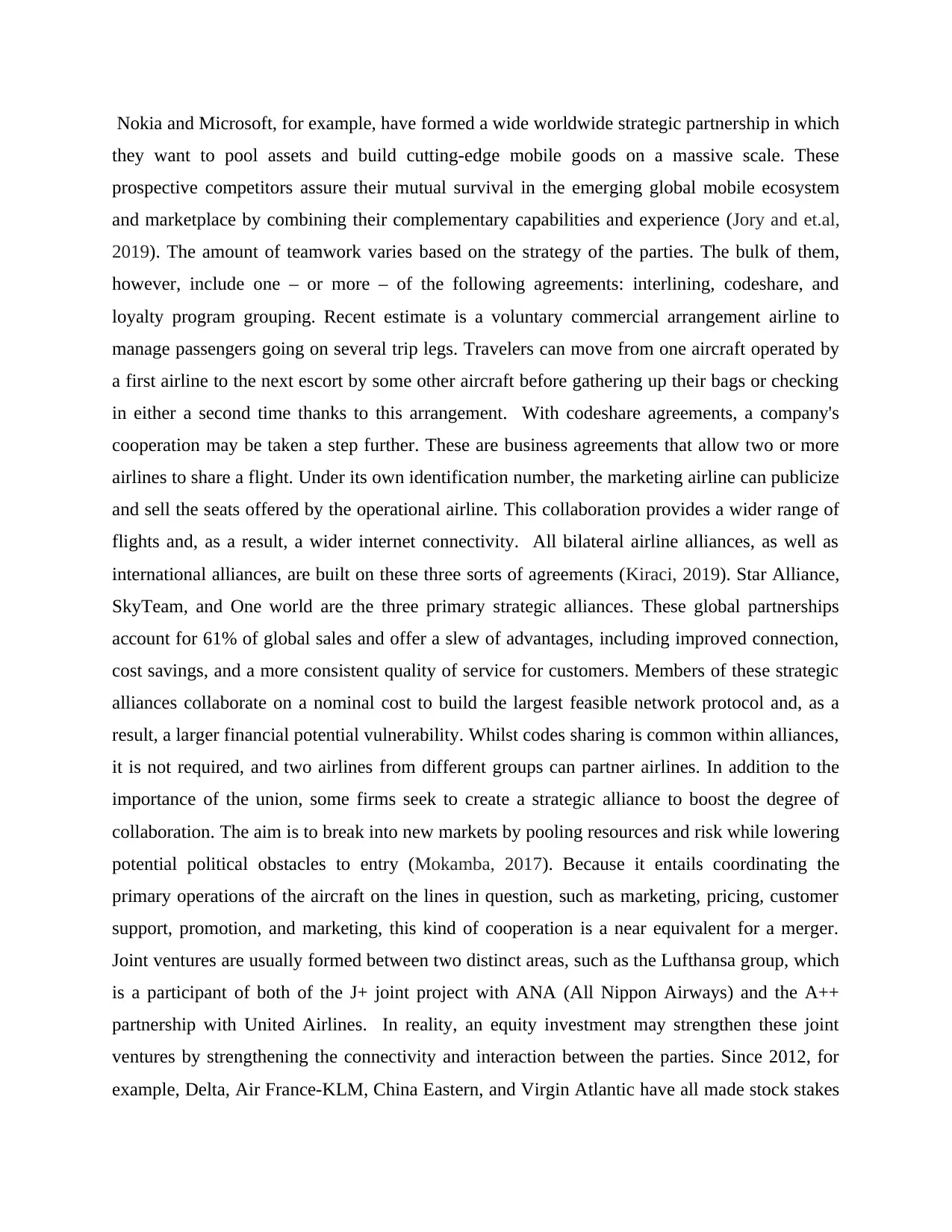
Nokia and Microsoft, for example, have formed a wide worldwide strategic partnership in which
they want to pool assets and build cutting-edge mobile goods on a massive scale. These
prospective competitors assure their mutual survival in the emerging global mobile ecosystem
and marketplace by combining their complementary capabilities and experience (Jory and et.al,
2019). The amount of teamwork varies based on the strategy of the parties. The bulk of them,
however, include one – or more – of the following agreements: interlining, codeshare, and
loyalty program grouping. Recent estimate is a voluntary commercial arrangement airline to
manage passengers going on several trip legs. Travelers can move from one aircraft operated by
a first airline to the next escort by some other aircraft before gathering up their bags or checking
in either a second time thanks to this arrangement. With codeshare agreements, a company's
cooperation may be taken a step further. These are business agreements that allow two or more
airlines to share a flight. Under its own identification number, the marketing airline can publicize
and sell the seats offered by the operational airline. This collaboration provides a wider range of
flights and, as a result, a wider internet connectivity. All bilateral airline alliances, as well as
international alliances, are built on these three sorts of agreements (Kiraci, 2019). Star Alliance,
SkyTeam, and One world are the three primary strategic alliances. These global partnerships
account for 61% of global sales and offer a slew of advantages, including improved connection,
cost savings, and a more consistent quality of service for customers. Members of these strategic
alliances collaborate on a nominal cost to build the largest feasible network protocol and, as a
result, a larger financial potential vulnerability. Whilst codes sharing is common within alliances,
it is not required, and two airlines from different groups can partner airlines. In addition to the
importance of the union, some firms seek to create a strategic alliance to boost the degree of
collaboration. The aim is to break into new markets by pooling resources and risk while lowering
potential political obstacles to entry (Mokamba, 2017). Because it entails coordinating the
primary operations of the aircraft on the lines in question, such as marketing, pricing, customer
support, promotion, and marketing, this kind of cooperation is a near equivalent for a merger.
Joint ventures are usually formed between two distinct areas, such as the Lufthansa group, which
is a participant of both of the J+ joint project with ANA (All Nippon Airways) and the A++
partnership with United Airlines. In reality, an equity investment may strengthen these joint
ventures by strengthening the connectivity and interaction between the parties. Since 2012, for
example, Delta, Air France-KLM, China Eastern, and Virgin Atlantic have all made stock stakes
they want to pool assets and build cutting-edge mobile goods on a massive scale. These
prospective competitors assure their mutual survival in the emerging global mobile ecosystem
and marketplace by combining their complementary capabilities and experience (Jory and et.al,
2019). The amount of teamwork varies based on the strategy of the parties. The bulk of them,
however, include one – or more – of the following agreements: interlining, codeshare, and
loyalty program grouping. Recent estimate is a voluntary commercial arrangement airline to
manage passengers going on several trip legs. Travelers can move from one aircraft operated by
a first airline to the next escort by some other aircraft before gathering up their bags or checking
in either a second time thanks to this arrangement. With codeshare agreements, a company's
cooperation may be taken a step further. These are business agreements that allow two or more
airlines to share a flight. Under its own identification number, the marketing airline can publicize
and sell the seats offered by the operational airline. This collaboration provides a wider range of
flights and, as a result, a wider internet connectivity. All bilateral airline alliances, as well as
international alliances, are built on these three sorts of agreements (Kiraci, 2019). Star Alliance,
SkyTeam, and One world are the three primary strategic alliances. These global partnerships
account for 61% of global sales and offer a slew of advantages, including improved connection,
cost savings, and a more consistent quality of service for customers. Members of these strategic
alliances collaborate on a nominal cost to build the largest feasible network protocol and, as a
result, a larger financial potential vulnerability. Whilst codes sharing is common within alliances,
it is not required, and two airlines from different groups can partner airlines. In addition to the
importance of the union, some firms seek to create a strategic alliance to boost the degree of
collaboration. The aim is to break into new markets by pooling resources and risk while lowering
potential political obstacles to entry (Mokamba, 2017). Because it entails coordinating the
primary operations of the aircraft on the lines in question, such as marketing, pricing, customer
support, promotion, and marketing, this kind of cooperation is a near equivalent for a merger.
Joint ventures are usually formed between two distinct areas, such as the Lufthansa group, which
is a participant of both of the J+ joint project with ANA (All Nippon Airways) and the A++
partnership with United Airlines. In reality, an equity investment may strengthen these joint
ventures by strengthening the connectivity and interaction between the parties. Since 2012, for
example, Delta, Air France-KLM, China Eastern, and Virgin Atlantic have all made stock stakes
⊘ This is a preview!⊘
Do you want full access?
Subscribe today to unlock all pages.

Trusted by 1+ million students worldwide
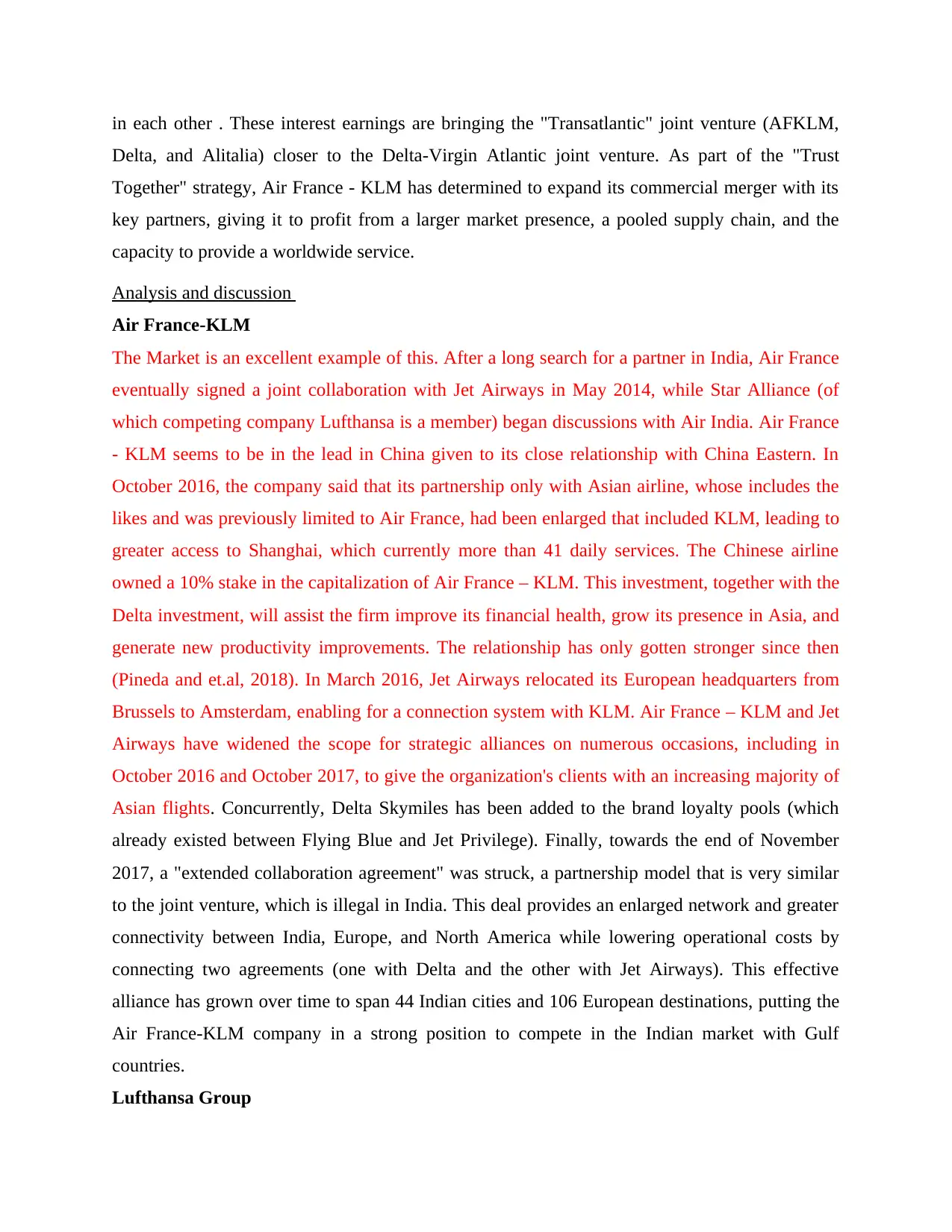
in each other . These interest earnings are bringing the "Transatlantic" joint venture (AFKLM,
Delta, and Alitalia) closer to the Delta-Virgin Atlantic joint venture. As part of the "Trust
Together" strategy, Air France - KLM has determined to expand its commercial merger with its
key partners, giving it to profit from a larger market presence, a pooled supply chain, and the
capacity to provide a worldwide service.
Analysis and discussion
Air France-KLM
The Market is an excellent example of this. After a long search for a partner in India, Air France
eventually signed a joint collaboration with Jet Airways in May 2014, while Star Alliance (of
which competing company Lufthansa is a member) began discussions with Air India. Air France
- KLM seems to be in the lead in China given to its close relationship with China Eastern. In
October 2016, the company said that its partnership only with Asian airline, whose includes the
likes and was previously limited to Air France, had been enlarged that included KLM, leading to
greater access to Shanghai, which currently more than 41 daily services. The Chinese airline
owned a 10% stake in the capitalization of Air France – KLM. This investment, together with the
Delta investment, will assist the firm improve its financial health, grow its presence in Asia, and
generate new productivity improvements. The relationship has only gotten stronger since then
(Pineda and et.al, 2018). In March 2016, Jet Airways relocated its European headquarters from
Brussels to Amsterdam, enabling for a connection system with KLM. Air France – KLM and Jet
Airways have widened the scope for strategic alliances on numerous occasions, including in
October 2016 and October 2017, to give the organization's clients with an increasing majority of
Asian flights. Concurrently, Delta Skymiles has been added to the brand loyalty pools (which
already existed between Flying Blue and Jet Privilege). Finally, towards the end of November
2017, a "extended collaboration agreement" was struck, a partnership model that is very similar
to the joint venture, which is illegal in India. This deal provides an enlarged network and greater
connectivity between India, Europe, and North America while lowering operational costs by
connecting two agreements (one with Delta and the other with Jet Airways). This effective
alliance has grown over time to span 44 Indian cities and 106 European destinations, putting the
Air France-KLM company in a strong position to compete in the Indian market with Gulf
countries.
Lufthansa Group
Delta, and Alitalia) closer to the Delta-Virgin Atlantic joint venture. As part of the "Trust
Together" strategy, Air France - KLM has determined to expand its commercial merger with its
key partners, giving it to profit from a larger market presence, a pooled supply chain, and the
capacity to provide a worldwide service.
Analysis and discussion
Air France-KLM
The Market is an excellent example of this. After a long search for a partner in India, Air France
eventually signed a joint collaboration with Jet Airways in May 2014, while Star Alliance (of
which competing company Lufthansa is a member) began discussions with Air India. Air France
- KLM seems to be in the lead in China given to its close relationship with China Eastern. In
October 2016, the company said that its partnership only with Asian airline, whose includes the
likes and was previously limited to Air France, had been enlarged that included KLM, leading to
greater access to Shanghai, which currently more than 41 daily services. The Chinese airline
owned a 10% stake in the capitalization of Air France – KLM. This investment, together with the
Delta investment, will assist the firm improve its financial health, grow its presence in Asia, and
generate new productivity improvements. The relationship has only gotten stronger since then
(Pineda and et.al, 2018). In March 2016, Jet Airways relocated its European headquarters from
Brussels to Amsterdam, enabling for a connection system with KLM. Air France – KLM and Jet
Airways have widened the scope for strategic alliances on numerous occasions, including in
October 2016 and October 2017, to give the organization's clients with an increasing majority of
Asian flights. Concurrently, Delta Skymiles has been added to the brand loyalty pools (which
already existed between Flying Blue and Jet Privilege). Finally, towards the end of November
2017, a "extended collaboration agreement" was struck, a partnership model that is very similar
to the joint venture, which is illegal in India. This deal provides an enlarged network and greater
connectivity between India, Europe, and North America while lowering operational costs by
connecting two agreements (one with Delta and the other with Jet Airways). This effective
alliance has grown over time to span 44 Indian cities and 106 European destinations, putting the
Air France-KLM company in a strong position to compete in the Indian market with Gulf
countries.
Lufthansa Group
Paraphrase This Document
Need a fresh take? Get an instant paraphrase of this document with our AI Paraphraser
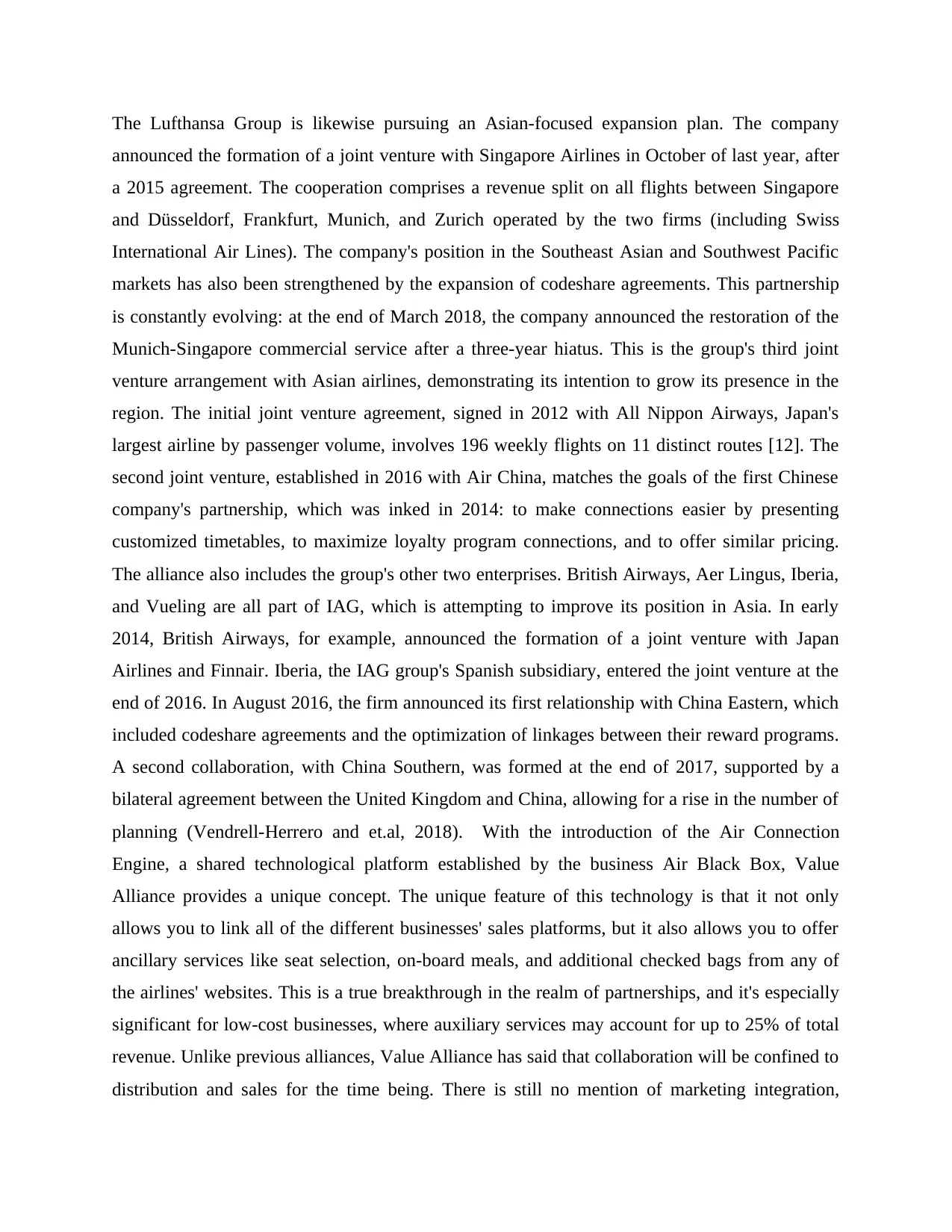
The Lufthansa Group is likewise pursuing an Asian-focused expansion plan. The company
announced the formation of a joint venture with Singapore Airlines in October of last year, after
a 2015 agreement. The cooperation comprises a revenue split on all flights between Singapore
and Düsseldorf, Frankfurt, Munich, and Zurich operated by the two firms (including Swiss
International Air Lines). The company's position in the Southeast Asian and Southwest Pacific
markets has also been strengthened by the expansion of codeshare agreements. This partnership
is constantly evolving: at the end of March 2018, the company announced the restoration of the
Munich-Singapore commercial service after a three-year hiatus. This is the group's third joint
venture arrangement with Asian airlines, demonstrating its intention to grow its presence in the
region. The initial joint venture agreement, signed in 2012 with All Nippon Airways, Japan's
largest airline by passenger volume, involves 196 weekly flights on 11 distinct routes [12]. The
second joint venture, established in 2016 with Air China, matches the goals of the first Chinese
company's partnership, which was inked in 2014: to make connections easier by presenting
customized timetables, to maximize loyalty program connections, and to offer similar pricing.
The alliance also includes the group's other two enterprises. British Airways, Aer Lingus, Iberia,
and Vueling are all part of IAG, which is attempting to improve its position in Asia. In early
2014, British Airways, for example, announced the formation of a joint venture with Japan
Airlines and Finnair. Iberia, the IAG group's Spanish subsidiary, entered the joint venture at the
end of 2016. In August 2016, the firm announced its first relationship with China Eastern, which
included codeshare agreements and the optimization of linkages between their reward programs.
A second collaboration, with China Southern, was formed at the end of 2017, supported by a
bilateral agreement between the United Kingdom and China, allowing for a rise in the number of
planning (Vendrell-Herrero and et.al, 2018). With the introduction of the Air Connection
Engine, a shared technological platform established by the business Air Black Box, Value
Alliance provides a unique concept. The unique feature of this technology is that it not only
allows you to link all of the different businesses' sales platforms, but it also allows you to offer
ancillary services like seat selection, on-board meals, and additional checked bags from any of
the airlines' websites. This is a true breakthrough in the realm of partnerships, and it's especially
significant for low-cost businesses, where auxiliary services may account for up to 25% of total
revenue. Unlike previous alliances, Value Alliance has said that collaboration will be confined to
distribution and sales for the time being. There is still no mention of marketing integration,
announced the formation of a joint venture with Singapore Airlines in October of last year, after
a 2015 agreement. The cooperation comprises a revenue split on all flights between Singapore
and Düsseldorf, Frankfurt, Munich, and Zurich operated by the two firms (including Swiss
International Air Lines). The company's position in the Southeast Asian and Southwest Pacific
markets has also been strengthened by the expansion of codeshare agreements. This partnership
is constantly evolving: at the end of March 2018, the company announced the restoration of the
Munich-Singapore commercial service after a three-year hiatus. This is the group's third joint
venture arrangement with Asian airlines, demonstrating its intention to grow its presence in the
region. The initial joint venture agreement, signed in 2012 with All Nippon Airways, Japan's
largest airline by passenger volume, involves 196 weekly flights on 11 distinct routes [12]. The
second joint venture, established in 2016 with Air China, matches the goals of the first Chinese
company's partnership, which was inked in 2014: to make connections easier by presenting
customized timetables, to maximize loyalty program connections, and to offer similar pricing.
The alliance also includes the group's other two enterprises. British Airways, Aer Lingus, Iberia,
and Vueling are all part of IAG, which is attempting to improve its position in Asia. In early
2014, British Airways, for example, announced the formation of a joint venture with Japan
Airlines and Finnair. Iberia, the IAG group's Spanish subsidiary, entered the joint venture at the
end of 2016. In August 2016, the firm announced its first relationship with China Eastern, which
included codeshare agreements and the optimization of linkages between their reward programs.
A second collaboration, with China Southern, was formed at the end of 2017, supported by a
bilateral agreement between the United Kingdom and China, allowing for a rise in the number of
planning (Vendrell-Herrero and et.al, 2018). With the introduction of the Air Connection
Engine, a shared technological platform established by the business Air Black Box, Value
Alliance provides a unique concept. The unique feature of this technology is that it not only
allows you to link all of the different businesses' sales platforms, but it also allows you to offer
ancillary services like seat selection, on-board meals, and additional checked bags from any of
the airlines' websites. This is a true breakthrough in the realm of partnerships, and it's especially
significant for low-cost businesses, where auxiliary services may account for up to 25% of total
revenue. Unlike previous alliances, Value Alliance has said that collaboration will be confined to
distribution and sales for the time being. There is still no mention of marketing integration,
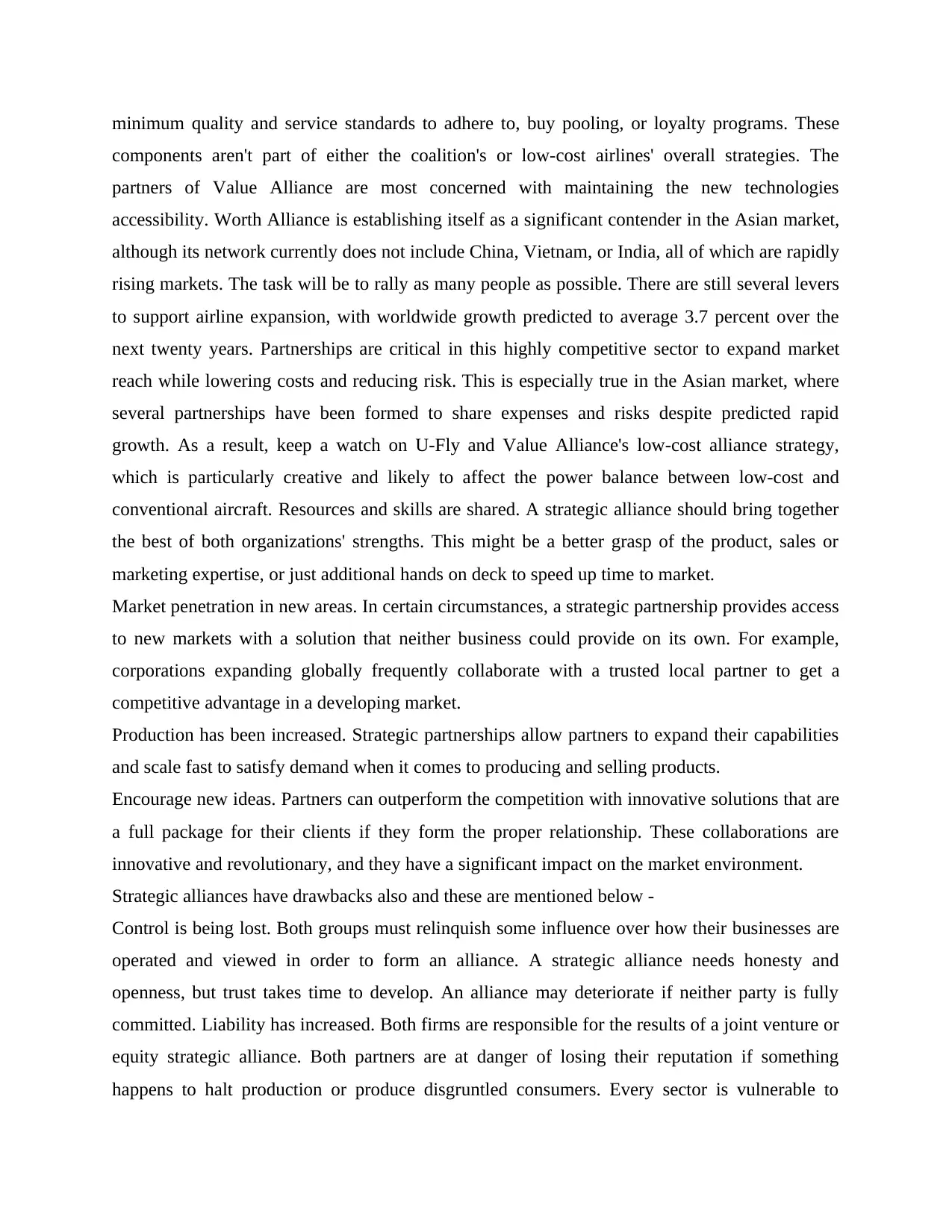
minimum quality and service standards to adhere to, buy pooling, or loyalty programs. These
components aren't part of either the coalition's or low-cost airlines' overall strategies. The
partners of Value Alliance are most concerned with maintaining the new technologies
accessibility. Worth Alliance is establishing itself as a significant contender in the Asian market,
although its network currently does not include China, Vietnam, or India, all of which are rapidly
rising markets. The task will be to rally as many people as possible. There are still several levers
to support airline expansion, with worldwide growth predicted to average 3.7 percent over the
next twenty years. Partnerships are critical in this highly competitive sector to expand market
reach while lowering costs and reducing risk. This is especially true in the Asian market, where
several partnerships have been formed to share expenses and risks despite predicted rapid
growth. As a result, keep a watch on U-Fly and Value Alliance's low-cost alliance strategy,
which is particularly creative and likely to affect the power balance between low-cost and
conventional aircraft. Resources and skills are shared. A strategic alliance should bring together
the best of both organizations' strengths. This might be a better grasp of the product, sales or
marketing expertise, or just additional hands on deck to speed up time to market.
Market penetration in new areas. In certain circumstances, a strategic partnership provides access
to new markets with a solution that neither business could provide on its own. For example,
corporations expanding globally frequently collaborate with a trusted local partner to get a
competitive advantage in a developing market.
Production has been increased. Strategic partnerships allow partners to expand their capabilities
and scale fast to satisfy demand when it comes to producing and selling products.
Encourage new ideas. Partners can outperform the competition with innovative solutions that are
a full package for their clients if they form the proper relationship. These collaborations are
innovative and revolutionary, and they have a significant impact on the market environment.
Strategic alliances have drawbacks also and these are mentioned below -
Control is being lost. Both groups must relinquish some influence over how their businesses are
operated and viewed in order to form an alliance. A strategic alliance needs honesty and
openness, but trust takes time to develop. An alliance may deteriorate if neither party is fully
committed. Liability has increased. Both firms are responsible for the results of a joint venture or
equity strategic alliance. Both partners are at danger of losing their reputation if something
happens to halt production or produce disgruntled consumers. Every sector is vulnerable to
components aren't part of either the coalition's or low-cost airlines' overall strategies. The
partners of Value Alliance are most concerned with maintaining the new technologies
accessibility. Worth Alliance is establishing itself as a significant contender in the Asian market,
although its network currently does not include China, Vietnam, or India, all of which are rapidly
rising markets. The task will be to rally as many people as possible. There are still several levers
to support airline expansion, with worldwide growth predicted to average 3.7 percent over the
next twenty years. Partnerships are critical in this highly competitive sector to expand market
reach while lowering costs and reducing risk. This is especially true in the Asian market, where
several partnerships have been formed to share expenses and risks despite predicted rapid
growth. As a result, keep a watch on U-Fly and Value Alliance's low-cost alliance strategy,
which is particularly creative and likely to affect the power balance between low-cost and
conventional aircraft. Resources and skills are shared. A strategic alliance should bring together
the best of both organizations' strengths. This might be a better grasp of the product, sales or
marketing expertise, or just additional hands on deck to speed up time to market.
Market penetration in new areas. In certain circumstances, a strategic partnership provides access
to new markets with a solution that neither business could provide on its own. For example,
corporations expanding globally frequently collaborate with a trusted local partner to get a
competitive advantage in a developing market.
Production has been increased. Strategic partnerships allow partners to expand their capabilities
and scale fast to satisfy demand when it comes to producing and selling products.
Encourage new ideas. Partners can outperform the competition with innovative solutions that are
a full package for their clients if they form the proper relationship. These collaborations are
innovative and revolutionary, and they have a significant impact on the market environment.
Strategic alliances have drawbacks also and these are mentioned below -
Control is being lost. Both groups must relinquish some influence over how their businesses are
operated and viewed in order to form an alliance. A strategic alliance needs honesty and
openness, but trust takes time to develop. An alliance may deteriorate if neither party is fully
committed. Liability has increased. Both firms are responsible for the results of a joint venture or
equity strategic alliance. Both partners are at danger of losing their reputation if something
happens to halt production or produce disgruntled consumers. Every sector is vulnerable to
⊘ This is a preview!⊘
Do you want full access?
Subscribe today to unlock all pages.

Trusted by 1+ million students worldwide
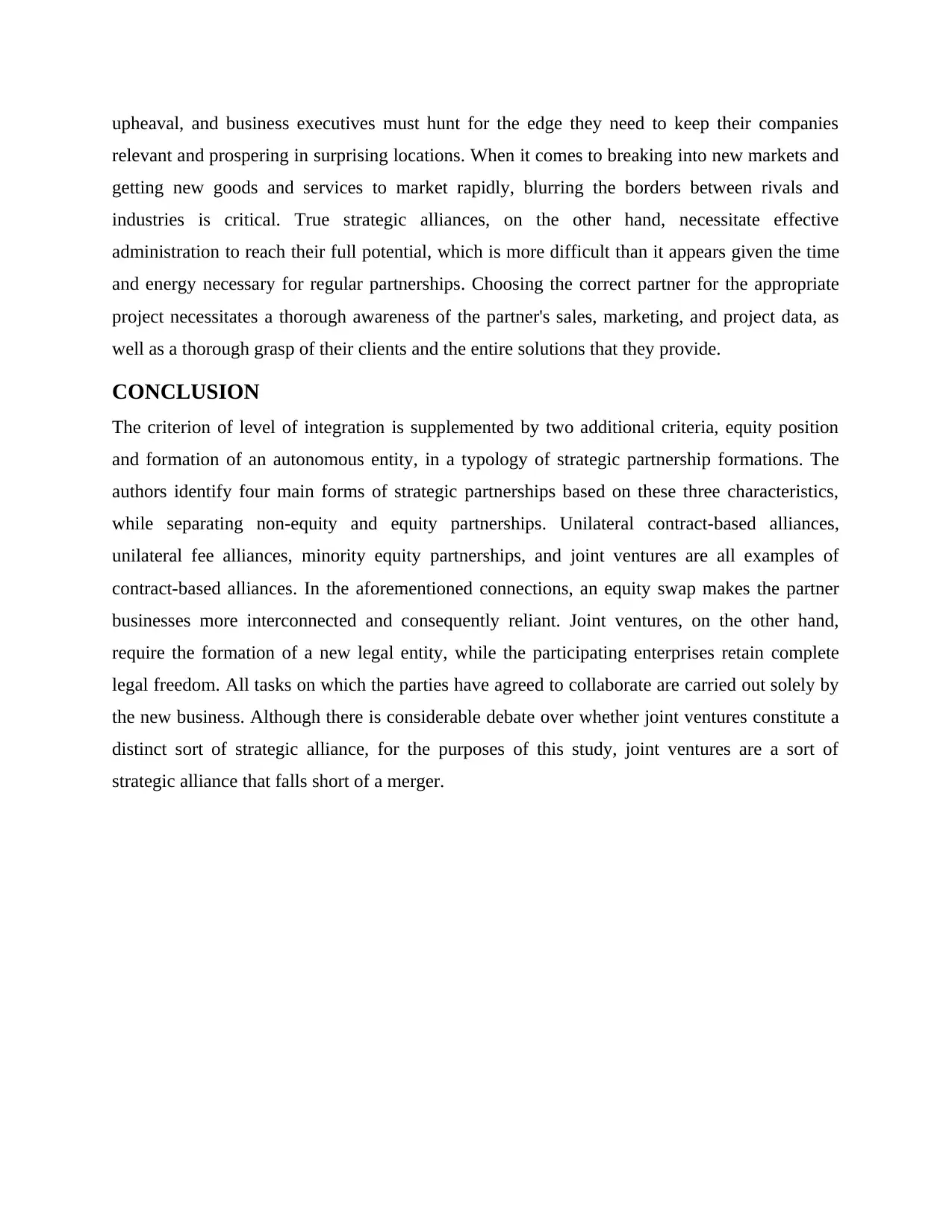
upheaval, and business executives must hunt for the edge they need to keep their companies
relevant and prospering in surprising locations. When it comes to breaking into new markets and
getting new goods and services to market rapidly, blurring the borders between rivals and
industries is critical. True strategic alliances, on the other hand, necessitate effective
administration to reach their full potential, which is more difficult than it appears given the time
and energy necessary for regular partnerships. Choosing the correct partner for the appropriate
project necessitates a thorough awareness of the partner's sales, marketing, and project data, as
well as a thorough grasp of their clients and the entire solutions that they provide.
CONCLUSION
The criterion of level of integration is supplemented by two additional criteria, equity position
and formation of an autonomous entity, in a typology of strategic partnership formations. The
authors identify four main forms of strategic partnerships based on these three characteristics,
while separating non-equity and equity partnerships. Unilateral contract-based alliances,
unilateral fee alliances, minority equity partnerships, and joint ventures are all examples of
contract-based alliances. In the aforementioned connections, an equity swap makes the partner
businesses more interconnected and consequently reliant. Joint ventures, on the other hand,
require the formation of a new legal entity, while the participating enterprises retain complete
legal freedom. All tasks on which the parties have agreed to collaborate are carried out solely by
the new business. Although there is considerable debate over whether joint ventures constitute a
distinct sort of strategic alliance, for the purposes of this study, joint ventures are a sort of
strategic alliance that falls short of a merger.
relevant and prospering in surprising locations. When it comes to breaking into new markets and
getting new goods and services to market rapidly, blurring the borders between rivals and
industries is critical. True strategic alliances, on the other hand, necessitate effective
administration to reach their full potential, which is more difficult than it appears given the time
and energy necessary for regular partnerships. Choosing the correct partner for the appropriate
project necessitates a thorough awareness of the partner's sales, marketing, and project data, as
well as a thorough grasp of their clients and the entire solutions that they provide.
CONCLUSION
The criterion of level of integration is supplemented by two additional criteria, equity position
and formation of an autonomous entity, in a typology of strategic partnership formations. The
authors identify four main forms of strategic partnerships based on these three characteristics,
while separating non-equity and equity partnerships. Unilateral contract-based alliances,
unilateral fee alliances, minority equity partnerships, and joint ventures are all examples of
contract-based alliances. In the aforementioned connections, an equity swap makes the partner
businesses more interconnected and consequently reliant. Joint ventures, on the other hand,
require the formation of a new legal entity, while the participating enterprises retain complete
legal freedom. All tasks on which the parties have agreed to collaborate are carried out solely by
the new business. Although there is considerable debate over whether joint ventures constitute a
distinct sort of strategic alliance, for the purposes of this study, joint ventures are a sort of
strategic alliance that falls short of a merger.
Paraphrase This Document
Need a fresh take? Get an instant paraphrase of this document with our AI Paraphraser
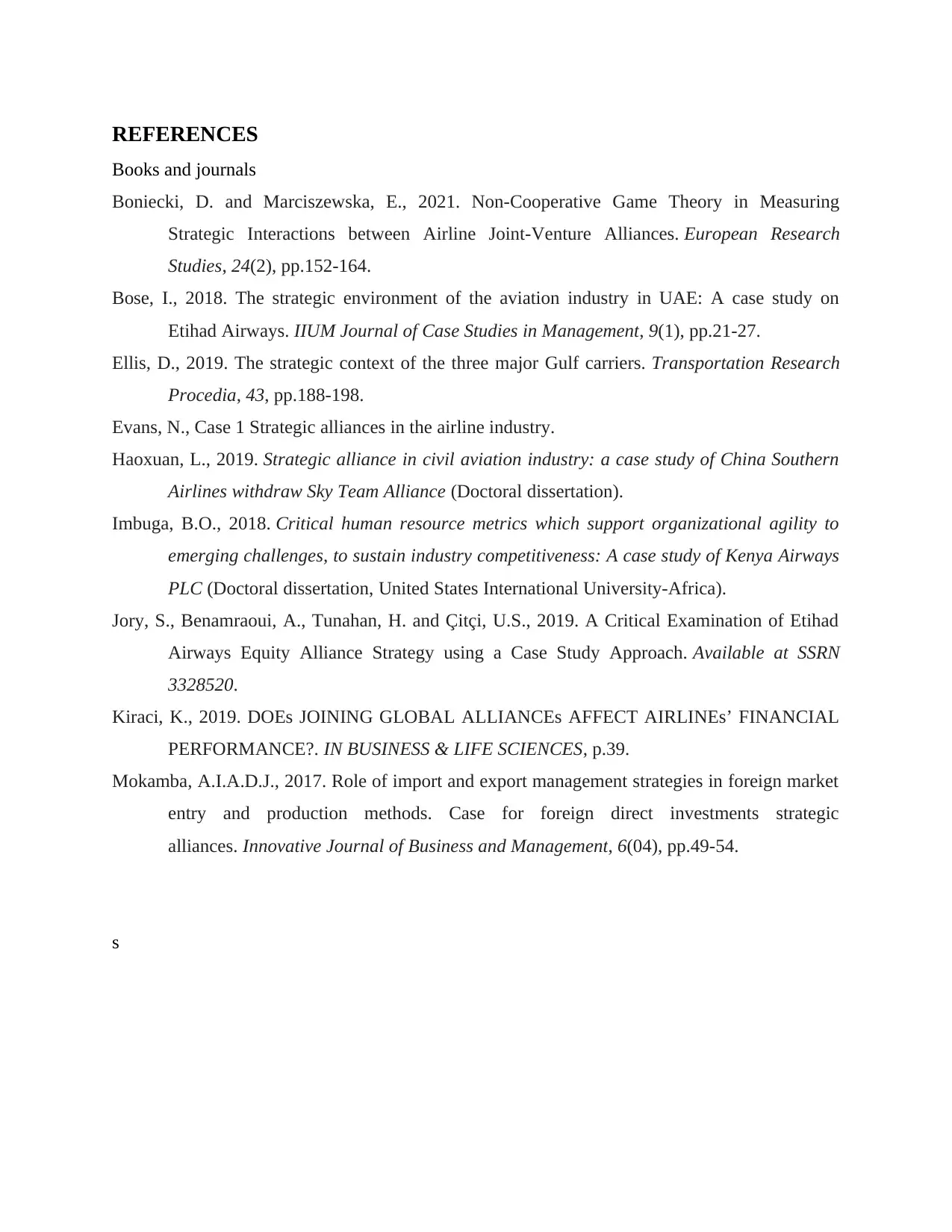
REFERENCES
Books and journals
Boniecki, D. and Marciszewska, E., 2021. Non-Cooperative Game Theory in Measuring
Strategic Interactions between Airline Joint-Venture Alliances. European Research
Studies, 24(2), pp.152-164.
Bose, I., 2018. The strategic environment of the aviation industry in UAE: A case study on
Etihad Airways. IIUM Journal of Case Studies in Management, 9(1), pp.21-27.
Ellis, D., 2019. The strategic context of the three major Gulf carriers. Transportation Research
Procedia, 43, pp.188-198.
Evans, N., Case 1 Strategic alliances in the airline industry.
Haoxuan, L., 2019. Strategic alliance in civil aviation industry: a case study of China Southern
Airlines withdraw Sky Team Alliance (Doctoral dissertation).
Imbuga, B.O., 2018. Critical human resource metrics which support organizational agility to
emerging challenges, to sustain industry competitiveness: A case study of Kenya Airways
PLC (Doctoral dissertation, United States International University-Africa).
Jory, S., Benamraoui, A., Tunahan, H. and Çitçi, U.S., 2019. A Critical Examination of Etihad
Airways Equity Alliance Strategy using a Case Study Approach. Available at SSRN
3328520.
Kiraci, K., 2019. DOEs JOINING GLOBAL ALLIANCEs AFFECT AIRLINEs’ FINANCIAL
PERFORMANCE?. IN BUSINESS & LIFE SCIENCES, p.39.
Mokamba, A.I.A.D.J., 2017. Role of import and export management strategies in foreign market
entry and production methods. Case for foreign direct investments strategic
alliances. Innovative Journal of Business and Management, 6(04), pp.49-54.
s
Books and journals
Boniecki, D. and Marciszewska, E., 2021. Non-Cooperative Game Theory in Measuring
Strategic Interactions between Airline Joint-Venture Alliances. European Research
Studies, 24(2), pp.152-164.
Bose, I., 2018. The strategic environment of the aviation industry in UAE: A case study on
Etihad Airways. IIUM Journal of Case Studies in Management, 9(1), pp.21-27.
Ellis, D., 2019. The strategic context of the three major Gulf carriers. Transportation Research
Procedia, 43, pp.188-198.
Evans, N., Case 1 Strategic alliances in the airline industry.
Haoxuan, L., 2019. Strategic alliance in civil aviation industry: a case study of China Southern
Airlines withdraw Sky Team Alliance (Doctoral dissertation).
Imbuga, B.O., 2018. Critical human resource metrics which support organizational agility to
emerging challenges, to sustain industry competitiveness: A case study of Kenya Airways
PLC (Doctoral dissertation, United States International University-Africa).
Jory, S., Benamraoui, A., Tunahan, H. and Çitçi, U.S., 2019. A Critical Examination of Etihad
Airways Equity Alliance Strategy using a Case Study Approach. Available at SSRN
3328520.
Kiraci, K., 2019. DOEs JOINING GLOBAL ALLIANCEs AFFECT AIRLINEs’ FINANCIAL
PERFORMANCE?. IN BUSINESS & LIFE SCIENCES, p.39.
Mokamba, A.I.A.D.J., 2017. Role of import and export management strategies in foreign market
entry and production methods. Case for foreign direct investments strategic
alliances. Innovative Journal of Business and Management, 6(04), pp.49-54.
s
1 out of 11
Related Documents
Your All-in-One AI-Powered Toolkit for Academic Success.
+13062052269
info@desklib.com
Available 24*7 on WhatsApp / Email
![[object Object]](/_next/static/media/star-bottom.7253800d.svg)
Unlock your academic potential
Copyright © 2020–2025 A2Z Services. All Rights Reserved. Developed and managed by ZUCOL.





